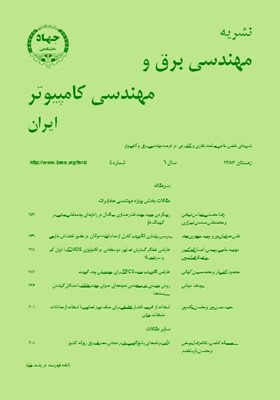تأثير برنامههاي پاسخگويي بار بر منحني مصرف برق روزانه کشور
محورهای موضوعی : مهندسی برق و کامپیوترحبيباله اعلمی 1 , غلامرضا یوسفی 2 , محسن پارسامقدم 3
1 - دانشگاه تربیت مدرس
2 - دانشکده برق و کامپیوتر
3 - دانشگاه تربیت مدرس
کلید واژه: الاستيسيته بارپاسخگويي بار اضطراريقيمت زمان استفادهمدل پاسخگويي بارمديريت مصرف,
چکیده مقاله :
استفاده از برنامههاي مديريت مصرف برق (DSM) يكي از بهترين روشهاي حفظ منافع مشترك جامعه، شركتهاي برق و مصرفكنندگان انرژي الكتريكي است. در سيستمهاي قدرت تجديد ساختاريافته، اين روشها تحت عنوان پاسخگويي بار ناميده ميشوند. در اين مقاله دو روش از روشهاي نهگانه پاسخگويي بار، قيمت زمان استفاده (TOU) و پاسخگويي بار اضطراري (EDRP)، بيان و مدل رياضي آنها (مدلهاي تكپريودي، چندپريودي و نهايي) با توجه به ضرايب حساسيت ديماند- قيمت استخراج شده است. در پايان، مدلهاي یادشده با لحاظ سناريوهاي مختلف بر روي منحني بار روزانه كشور ايران مورد تست و ارزيابي قرار گرفته و منحنيهای مصرف جدید، میزان انرژی مصرفی، درصد کاهش پیک، مبلغ درآمد شرکت برق، میزان جایزه پرداختی و مقدار سود مشتري در هر سناريو محاسبه شده است.
Demand side management (DSM) is one of the most important methods which have been used to maximize the benefits of the electric power market participants. In the deregulated power systems, DSM is called demand response (DR). In this paper, two DR programs have been focused: time-of-use (TOU) and emergency demand response program (EDRP). In this paper DR is modeled considering both TOU and EDRP methods, simultaneously, using the single and multi period load models, based on the load elasticity concept. The proposed model is implemented on the peak load of the Iranian Power Grid and the optimum prices for TOU program and the optimum incentives for combined TOU and EDRP programs are determined.
[1]C. River Associates, "Primer on demand side management," in Report for the World Bank, pp. 6-9, Feb. 2005.
[2]U. S. Department of Energy,Energy Policy Act of 2005, Section1252, pp. 372-375, Feb. 2006.
[3]J. Wellinghoff,Collaborative Dialog on Demand Response, 12 Nov.2006, www.ferc.gov.
[4]IEA, Strategic Plan for the IEA Demand-Side ManagementPrograms 2004-2009, www.iea.org.
[5]FERC, Regulatory Commission Survey on Demand Response andTime Based Rate Programs/Tariffs, Aug. 2006, www.ferc.gov.
[6]D. Cirio, G. Demartini, S. Massucco, A. Monni, P. Scaler,F. Silvestvo, and G. Vimercati, "Load control for improving systemsecurity and economics," inProc. IEEE Power Tech Conf., vol. 4,pp. 1-8, Jun. 2003.
[7]M. Fahliglu and F. L. Alvarado, "Designing incentive compatible contracts for effective demand management," IEEE Trans. on Power Systems , vol. 15, no. 4, pp. 1255-1260, Nov. 2000.
[8]Y. Li and F. Peter, "Deregulated power prices: changes over time,"IEEE Trans. on Power Systems, vol. 20, no. 2, pp. 565-572,May 2005.
[9]Y. Tang, H. Song, and F. Ho, "Investigation on TOU pricing principles," inIEEE TBD Conf., vol. 1, pp. 1-9, Dec. 2005.
[10]N. Yu and J. Yu, "Optimal TOU decision considering demand response model," in Proc. Int. Conf. on Power System Technology,pp. 1-5, Jun. 2006.
[11]D. S. Kirschen, "Demand-side view of electricity markets,"IEEETrans. on Power Systems , vol. 18, no. 2, pp. 520-527, May 2003.
[12]D. S. Kirschen, G. Strbac, P. Cumperayot, and D. Mendes,"Factoring the elasticity of demand in electricity prices," IEEETrans. on Power Systems, vol. 15, no. 2, pp. 612-617, May 2000.
[13]D. S. Kirschen and G. Strbac,Fundamentals of Power System Economics, John Wiley & Sons, 2004.
[14]F. C. Schweppe, M. C. Caramanis, R. D. Tabors, and R. E. Bohn,Spot Pricing of Electricity, Appendix E, Kluwer AcademicPublishers, 1998.
[15]J. G. Roos and I. E. Lane, "Industrial power demand response analysis for one port real time pricing,"IEEE Trans. on PowerSystem, vol. 13, no. 1, pp. 159-164, Feb. 1998.
[16]H. Yang, Y. Zhang, and X. Tong,System Dynamics Model forDemand Side Management, Hunan Provincial Natural ScienceFoundation of China, No. 05JJ3 0/07, 2006.
[17]آمار تفصیلی صنعت برق ایران،وزارت نیرو،1386.
[18]ترازنامه انرژی،وزارت نیرو،صفحه281، 1385.
[19] the World Bank (ESMAP), Demand - Side Management in China’s Restructured Power Industry, Dec. 2005.
[20] اقدامات و نتایج طرح های بهینه¬سازی مصرف انرژی،امور انرژی،وزارت نیرو،1381.
[21]ف. فصیحی هرندی و م. صادقی، "بررسی عملکرد ابزارهای مدیریت مصرف انرژی الکتریکی در ایران، "نشریه انرژی ایران"،د.8،ش.19،صص 31-54،اردیبهشت1383.
[22]ح. ا. اعلمی، م. پارسا¬مقدم و غ. ر. یوسفی،" تعیین مقدار بهینه پاداش برنامه پاسخ¬گویی بار اضطراری با استفاده از مدلDR،"کنفرانس بین¬المللی برق،توانیر،ش 283،آبان 1386.

